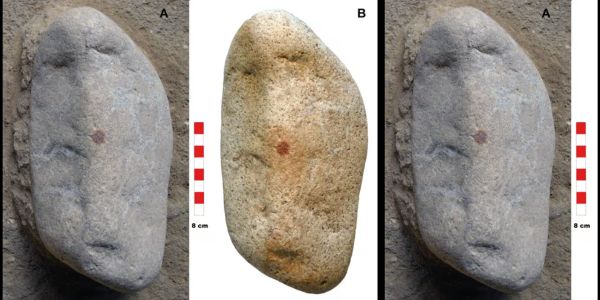In a groundbreaking discovery, archaeologists in Spain have uncovered what is believed to be the oldest complete human fingerprint ever found, dating back 43,000 years.
Discovered in the San Lazaro rock shelter near Segovia, central Spain, this remarkable find—a red ochre fingerprint on a granite pebble—offers new insights into the cognitive and artistic abilities of Neanderthals, our ancient human cousins.
A Prehistoric Artist’s Mark
The small granite pebble, marked with a deliberate red dot, was likely selected for its face-like shape, suggesting an early form of symbolic art. Researchers propose that a Neanderthal, possibly an adult male, dipped their finger in red ochre pigment to create the mark, potentially representing a human face. This discovery, published in the journal Archaeological and Anthropological Sciences, challenges long-held assumptions about Neanderthal intelligence and creativity.
“The pebble was chosen for its appearance and marked with ochre, showing a human mind capable of symbolizing, imagining, and projecting thoughts onto an object,” the study authors noted. This act may reflect three cognitive processes: mental conception of an image, deliberate communication, and attribution of meaning.
Must Read: Humans Emit Subtle Light: A Fascinating Discovery
Scientific Breakthrough in Segovia
The San Lazaro rock shelter, located in Spain’s heartland, has become a focal point for archaeologists. The team, including experts from Complutense University of Madrid, the Geological and Mining Institute of Spain, and the University of Salamanca, used advanced techniques like scanning electron microscopy and multispectral spectroscopy to analyze the pebble. Forensic analysis by Spain’s scientific police confirmed the red dot as a human fingerprint, making it the oldest complete example known, surpassing a partial Neanderthal fingerprint previously found in Germany.
The artifact’s age, determined by dating the Middle Paleolithic layer where it was found, places it firmly in the Neanderthal era, before modern humans (Homo sapiens) arrived in the Iberian Peninsula around 45,000 years ago. This timeline underscores the Neanderthals’ capacity for abstraction, possibly experiencing pareidolia—the tendency to see faces in objects—much like modern humans.
Neanderthals: Artists of Prehistory?
This discovery fuels ongoing debates about Neanderthal behavior. “If this pebble had been marked 5,000 years ago by Homo sapiens, it would be called art without hesitation,” said Professor de Andres-Herrero from Complutense University. The find suggests Neanderthals, who vanished around 40,000 years ago, were capable of symbolic expression, a trait once thought exclusive to modern humans.
The pebble’s red mark, possibly a nose on a face-like stone, could represent one of the earliest human facial symbolizations in prehistory. This aligns with other evidence of Neanderthal creativity, such as cave paintings and engraved bones found across Europe.
Must Read: 5,000-Year-Old Royal Tomb Unearthed in China: Secrets of a Lost Kingdom Revealed
Why This Matters
The San Lazaro fingerprint not only rewrites our understanding of Neanderthal capabilities but also highlights Spain’s rich archaeological heritage. The Atapuerca Mountains, another key site in Spain, have yielded fossils of early humans dating back 1.4 million years, but this new find brings us closer to the daily lives and minds of Neanderthals.
As researchers continue to study the pebble, questions remain: Was this an isolated act of creativity, or part of a broader Neanderthal artistic tradition? The discovery opens doors to further exploration of prehistoric cognition and culture.

